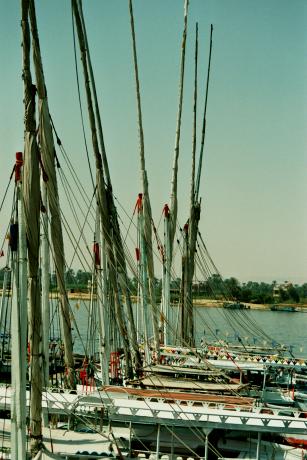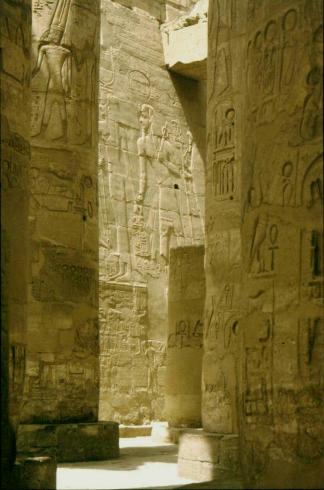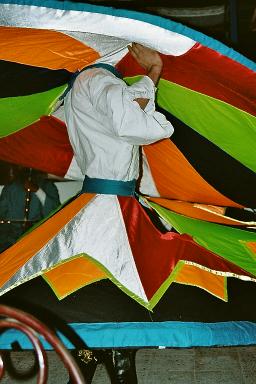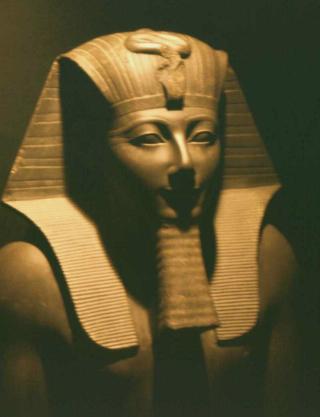|
Please be aware that entrance fees are not included in the quoted prices as they are subject to change at any time. We will be happy to organise the tickets for you. Also an official Guide who speaks your language and who will accompany you to the various sights and monuments can be arranged for at an additional fee.
Again, these are a few suggestions. There are countless places, sights and events to go to, see and participate in. Its all waiting for you to discover.
|
The Kings and Queens of Thebes

|
The Valley of the Kings and Queens is located on the West Bank at Luxor (ancient Thebes). There are many tombs belonging to the Pharaohs and Queens of the 18th, 19th and 20th Dynasties. Usually one ticket allows for a visit to three of the tombs. Not all tombs are open at the same time.
|
Links to more detailed information:
http://en.wikipedia.org/wiki/Valley_of _the_Kings
http://touregypt.net/queens.htm
http://lexicorient.com/egypt/luxor24. htm
|
|
The Temples of Thebes
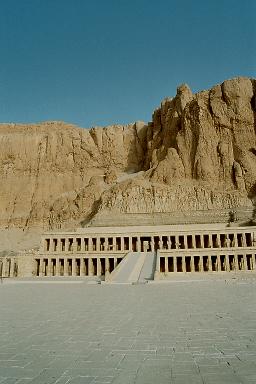
|
Thebes has some of the best preserved monuments of Ancient Egypt, even if the old settlement is now covered by modern houses.
On the western side of the Nile lie many important monuments. These include the colossi of Memnon, the Ramesseum of Ramses II, the temple of Ramses III, and the temple of Queen Hatshepsut.
Hatshepsut is the only woman ruling Egypt as a pharaoh, but this only happened through clever use of coalitions and marriage. She was the daughter of Tuthmosis 2, married to Tuthmosis 3 and after his death she claimed effective power by marrying infant Tuthmosis 4.
Her temple at the foot of the Theban hills is among the most effectively designed structures of all of Egypt. While employing most of the grand effects of common temples, this temple makes use of open space and contrasts with nature. Most of the area is based upon the experience of the arrival. Wide columned halls are put on top of each others, with two ramps bringing you up to the 2nd floor, which is deliberately dwarfed by the huge hills in the back. But the temple almost continues into the hills, and the hills are not just any hills. It is the other side of the Valley of Kings, the place where kings built tombs in the form of shafts connecting to the underworld.
|
http://www.egyptologyonline.com/th ebes.htm
http://www.eternalegypt.org/
|
|
Deir El Medina / The Worker’s Village

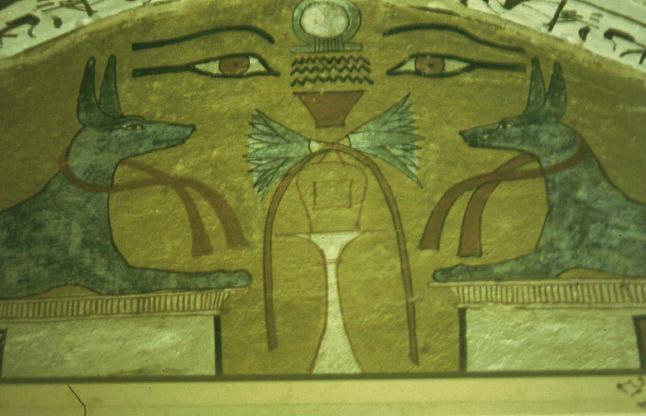
|
The Workers' Village is a one of a kind-site. It is so fabulously reenacted and so delicately restored. You feel that you can almost imagine how life was here 3000 years ago.
The people living here were masons, painters and sculptors working mainly at the Valley of the Kings. It must be the skills of the inhabitants that is the reason for this being the best preserved village of its times.
Of the Workers' Village two main attractions, one is only available for researchers: Since so many of the inhabitants here were literate, there is an abundance of written material telling about everyday life among them. Feuds and quarrels are among the details preserved for eternity.
The other attraction is the main reason for visitors coming here: The tombs. There are 3 open for visitors, and these attract people because of the high quality of the labour and the excellent condition. Decorations have many similarities with what you find in the Valley of the Kings, of course, but the scale is different, and the tomb owners are presented in a far more modest manner than the kings had ordered.
|
|
|
Dendera and Abydos
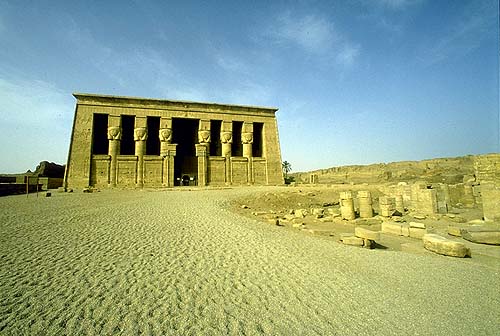
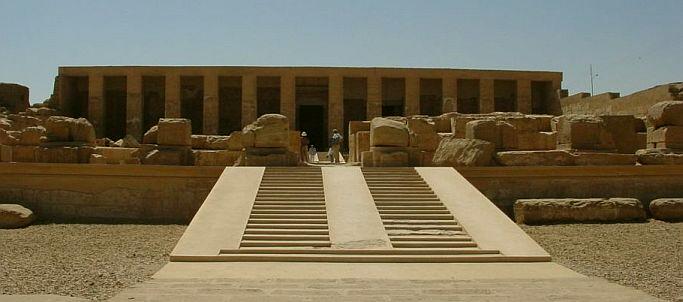
|
Dendera
The temple of Dendera as we know today was reconstructed during the Ptolemaic period on top of a much older temple which already existed in the 4th century B.C. The temple is known as the Hathor-temple, but was also dedicated to the husband Horus and son Ihy (at that time there were 3 sanctuaries). Today it's also well-known for the representation of Cleopatra VII Philopator and Ptolemy XV Caesar, Cleopatra's son by Julius Caesar on the south wall.
Abydos
Once all Egyptians had to make a pilgrimage to Abydos, at least once in a life-time. Here was the centre of the Osiris-cult. The most important relic of the God, his head, was preserved in the sanctuary of Osiris. The most beautiful thing in Abydos is the temple of Seti I., well preserved and famous for its splendid paintings. The temple was dedicated to 7 gods and goddesses represented in 7 small chapels: Horus (with the head of a falcon), Isis (with horns of a cow), Osiris (as a mummy), Amun-Re (as a human being with plumed head), Re-Harakhte (as a falcon with sun disk), Ptah (with bald head, little beard and a staff) and the deified Seti I (with a cobra on his head).
|
|
|
A day on the Nile
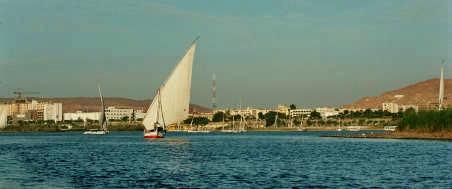

|
The Nile (iteru in Ancient Egyptian) was the lifeline of the ancient Egyptian civilization, with most of the population and all of the cities of Egypt resting along those parts of the Nile valley lying north of Aswan. The Nile has been the lifeline for Egyptian culture since the Stone Age. Climate change - or perhaps overgrazing - about 8000 BC desiccated the pastoral lands of Egypt to form the Sahara, and the tribes naturally migrated to the river, where they developed a settled agricultural economy and a more-centralized society.
A felucca is a traditional wooden sailing boat used in protected waters of the Red Sea and eastern Mediterranean including Malta, and particularly along the Nile in Egypt. Its rig consists of one or two lateen sails.
They are usually able to board ten-some passengers and the crew consists of two or three people. Despite being obsoleted by motorboats and ferries, feluccas are still in active use as a means of transport in Nile-adjacent cities like Aswan or Luxor. They are especially popular among tourists who can enjoy their quieter and calmer mood than motorboats have to offer.
|
|
|
Luxor City
UP
|
Many stories have been written about Luxor, its history, its monuments and its people and you will find countless places on the Internet about it. We are going to show you our city as we know it. The places we enjoy, the little shops and corners we visit, the ‘secrets’ that usually tourists don’t get to hear and see.
Beside the big souk in Luxor there are a small number of shops with the finest in Egyptian craft and artisana you can find. Fare Trade contracts with groups and individuals to buy products directly from them at fair prices, have been initiated and deserve our full support.
Discover the city riding in one of the traditional kalesh (horse carriages).
And of course Luxor has a night-life too; eat dinner and watch the Whirling Derwish perform or have a night out at one of the bars and discoes of the big hotels.
An absolut must when visiting Luxor is the Luxor Museum, a real jewel among the museums of Egypt.
|

|
|









